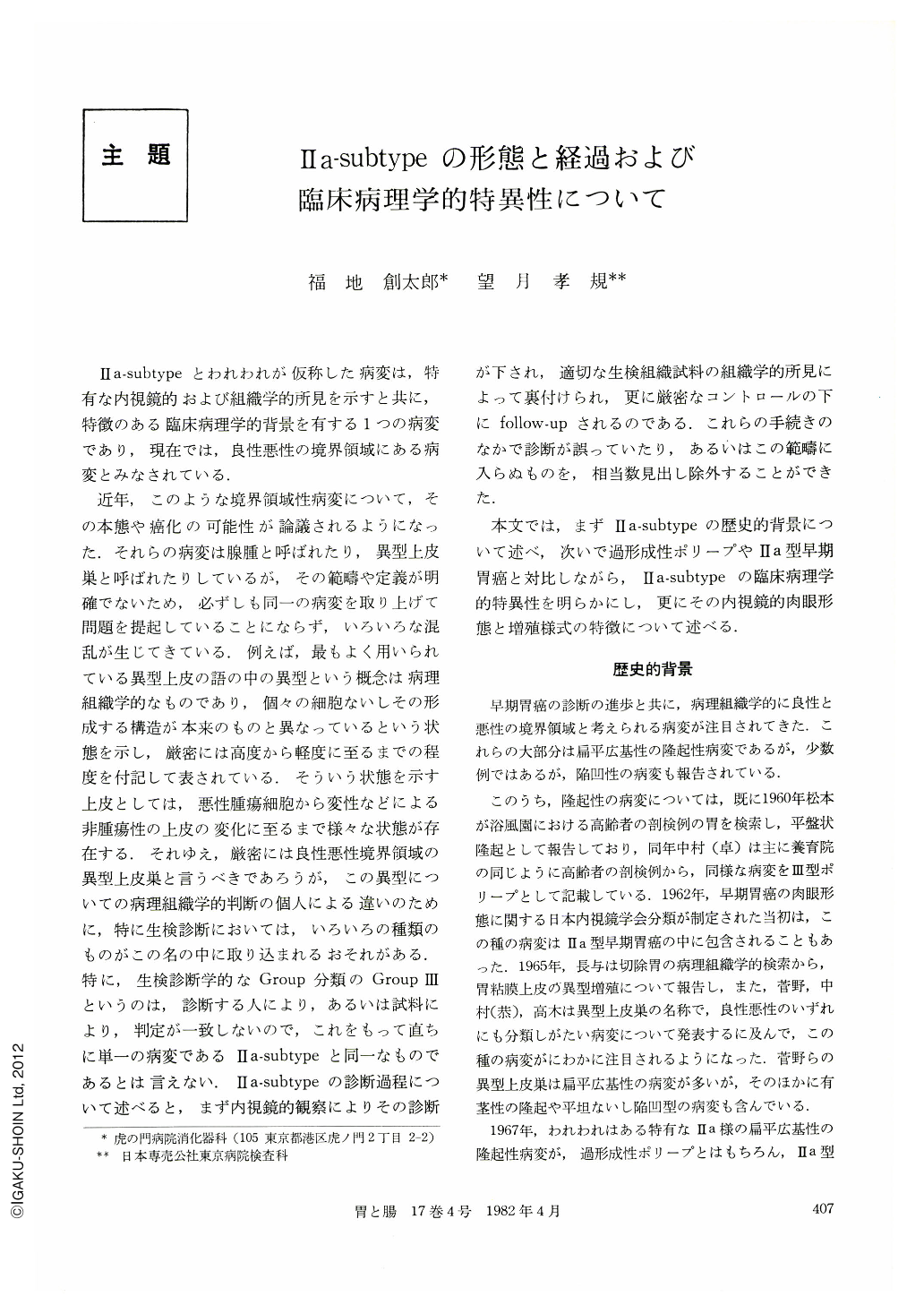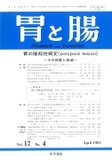Japanese
English
- 有料閲覧
- Abstract 文献概要
- 1ページ目 Look Inside
- サイト内被引用 Cited by
Ⅱa-subtypeとわれわれが仮称した病変は,特有な内視鏡的および組織学的所見を示すと共に,特徴のある臨床病理学的背景を有する1つの病変であり,現在では,良性悪性の境界領域にある病変とみなされている.
近年,このような境界領域性病変について,その本態や癌化の可能性が論議されるようになった.それらの病変は腺腫と呼ばれたり,異型上皮巣と呼ばれたりしているが,その範疇や定義が明確でないため,必ずしも同一の病変を取り上げて問題を提起していることにならず,いろいろな混乱が生じてきている.例えば,最もよく用いられている異型上皮の語の中の異型という概念は病理組織学的なものであり,個々の細胞ないしその形成する構造が本来のものと異なっているという状態を示し,厳密には高度から軽度に至るまでの程度を付記して表されている.そういう状態を示す上皮としては,悪性腫瘍細胞から変性などによる非腫瘍性の上皮の変化に至るまで様々な状態が存在する.それゆえ,厳密には良性悪性境界領域の異型上皮巣と言うべきであろうが,この異型についての病理組織学的判断の個人による違いのために,特に生検診断においては,いろいろの種類のものがこの名の中に取り込まれるおそれがある.特に,生検診断学的なGroup分類のGroup Ⅲというのは,診断する人により,あるいは試料により,判定が一致しないので,これをもって直ちに単一の病変であるⅡa-subtypeと同一なものであるとは言えない.Ⅱa-subtypeの診断過程について述べると,まず内視鏡的観察によりその診断が下され,適切な生検組織試料の組織学的所見によって裏付けられ,更に厳密なコントロールの下にfollow-upされるのである.これらの手続きのなかで診断が誤っていたり,あるいはこの範疇に入らぬものを,相当数見出し除外することができた.
Clinicopathological background of IIa-subtype is quite characteristic because it is almost always seen in aged patients who have severe atrophic gastric mucosa associated with intestinal metaplasia. Their gastric secretory function is markedly reduced and there is also increased incidence of coexisting well-differentiated adenocarcinoma in the same stomach.
These characteristics are quite different from hyperplastic polyps and forming a pronounced contrast with them. Clinicopathological background of polypoid cancer is mimic to the IIa-subtype but a degree of mucosal devastation and decreased secretory function are more prominent rather in the IIa-subtype. Fundamental macroscopic feature of the IIa-subtype is flat protruded lesion with broad base similar to IIa. Studying the clinical course, its growth presumed to be very slow and it may become hemispherical but rarely has stalk. Although follow-up of clinical course of the IIa-subtype has been still less than 10 years, most cases showed no significant changes and repeated biopsies caused its decrease in size or disappearance in some cases.
These facts suggest that the IIa-subtype has less proliferative character. Excluding misdiagnosed cases, no essential change in the histology of the biopsy specimen has been noted and so far no cases have been reported to have a sign of malignancy or differentiation into metaplastic intestinal epithelium.
The above findings suggest that the lesion of IIa-subtype, which is our tentative name, is a distinctive clinical entity and it is considered to be one of the representative case of protruded epithelial lesions along with benign hyperplastic polyp and malignant polypoid lesion. However, it has not been well defined whether the lesion is considered to be neoplastic proliferation or adenoma.

Copyright © 1982, Igaku-Shoin Ltd. All rights reserved.


